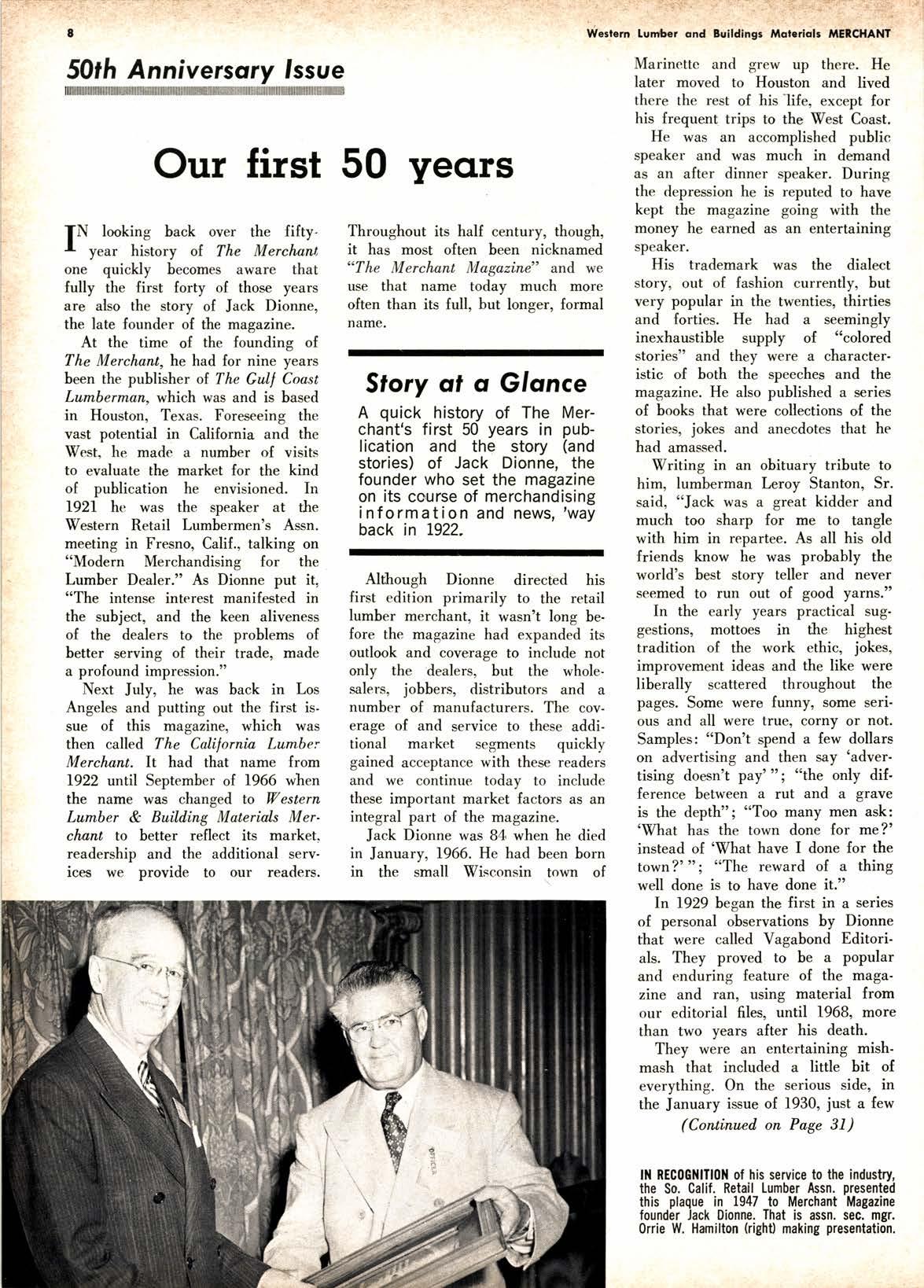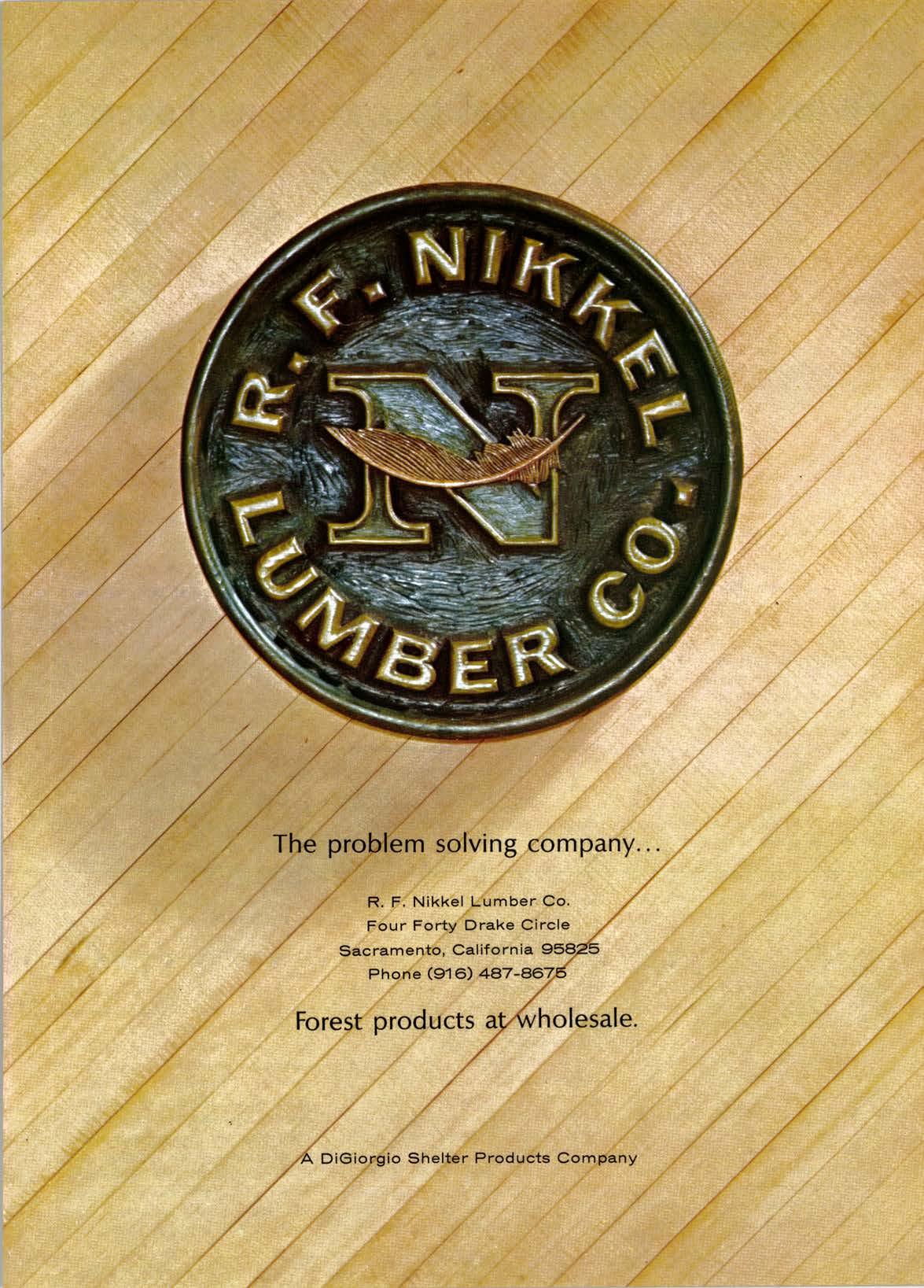
3 minute read
Our first 50 yeqrs
fN looking back over the fifty- I year historv oI The Merchant one quickly b""o-u. aware that fully the first forty of those years are also the story of Jack Dionne, the late founder of the magazine.
At the time of the founding of The Merchanr, he had for nine years been the publisher oI The Cull Coast Lumberrnan, which was and is based in Houston, Texas. Foreseeing the vast potential in California and the West, he made a number of visits to evaluate the market for the kind of publication he envisioned. In 1921 he was the speaker at the Western Retail Lumbermen's Assn. meeting in Fresnq Calif., talking on "Modern Merchandising for the Lumber Dealer.'n fu Dionne put it, "The intense interest manifested in the subject, and tho keen aliveness of the dealers to the problems of better serving of their trade, made a profound impression."
Next July, he was back in Los Angeles and putting out the first issue of this magazine, which was then called The Calilornia Lumber Merch.ant. It had that name from 1922 until September of 1966 when the name was changed to Western Lum.ber & Builcling Materiqls Merclwnt to better reflect its market. readership and the additional services we provide to our readers.
Throughout its half century, though, it has most often been nicknamed o'The Merclwnt fuIagazine" and we use that name today much more often than its full, but longer, formal name.
Slory d] d Glonce
A quick history of The Merchant's first 50 years in publication and the story (and stories) of Jack Dionne, the founder who set the magazine on its course of merchandising information and news,'way back in L922.
Although Dionne directed his first edition primarily to the retail lumber merchant, it wasn't long before the magazine had expanded its outlook and coverage to include not only the dealers, but the wholesalers, jobbers, distributors and a number of manufacturers. The coverage of and service to these additional market segments quickly gained acceptance with these readers and we continue today to include these important market factors as an integral part of the magazine.
Jack Dionne was 84 when he died in January, 1966. He had been born in the small Wisconsin .town of
Marinette and grew up there. He later moved to Houston and lived there the rest of his'life, except for his frequent trips to the West Coast.
He was an accomplished public speaker and was much in demand as an after dinner speaker. During the depression he is reputed to have kept the magazine going with the money he earned as an entertaining speaker.
His trademark was the dialect story, out of fashion currently, but very popular in the twenties, thirties and forties. He had a seemingly inexhaustible supply of "colored stories" and they were a characteristic of both the speeches and the maplazine. He also published a series of books that were eollections of the stories, jokes and anecdotes that he had amassed.
Writing in an obituary tribute to him, lumberman l,eroy Stanton, Sr. said, "Jack was a great kidder and much too sharp for me to tangle with him in repartee. As all his old friends know he was probably the world's best story teller and never seemed to run out of good yarns."
In the early years practical suggestions, mottoes in the highest tradition of the work ethic, jokes, improvement ideas and the like were liberally scattered throughout the pages. Some were funny, some serious and all were true, corny or not. Samples: "Don't spend a few dollars on advertising and then say 'advertising doesn't puy'"I "the only difference between a rut and a grave is the depth"; o'Too many men ask: 'What has the town done for me?' instead of 'What have I done for the town?"'; 'oThe reward of a thing well done is to have done it."
In 1929 began the first in a series of personal observations by Dionne that were called Vagabond Editorials. They proved to be a popular and enduring feature of the magazine and ran, using material from our editorial files, until 1968, more than two years after his death.
They were an entertaining mishmash that included a little bit of everything. On the serious side, in the January issue of 1930, just a few (Conrinu,ed on Page 31)











